Incorporating the Mediterranean Diet into Your Day-to-Day Routine Could Yield a Number of Benefits, Here’s How.
In a world where dietary trends come and go with the seasons, the Mediterranean diet has steadfastly held its ground. This diet is not just a culinary experience, but a lifestyle steeped in real history spanning several cultures. It’s more of a culinary philosophy, with roots deeply entrenched in the sun-kissed regions surrounding the Mediterranean Sea. It’s a blend of flavors, traditions, and health benefits that have been cherished for centuries.
History and Origin of the Mediterranean Diet
The term “Mediterranean diet” was coined in the middle of the 20th century, and primarily encapsulates the traditional eating habits of communities residing along the Mediterranean Sea, dating back to ancient times.
This dietary pattern is a confluence of culinary traditions from countries such as Greece, Italy, and Spain, among others. It is believed that the diet has its roots in the dietary patterns of ancient Greece and Rome. In these ancient cultures, the diet was a reflection of the agrarian lifestyle of the region. Unintentional emphasis was placed not only on seasonal and locally sourced foods, but it also coincided with day-to-day physical and social activity. These practices and mindsets continue to be natural staples in Mediterranean culture today.
Move the timeline up 2,000 years or so, and the diet gained prominence and global recognition post the 1950s, when researchers noticed a significant reduction in chronic diseases and higher life expectancy among the populations adhering to this dietary pattern.
Now, populations outside of the Mediterranean region put it into practice intentionally given its mental and physical benefits.
RELATED: Best Greek Islands to Visit for Different Types of Travelers: Which Island is Right for You?
What Foods Primary Are Included in the Mediterranean Diet?
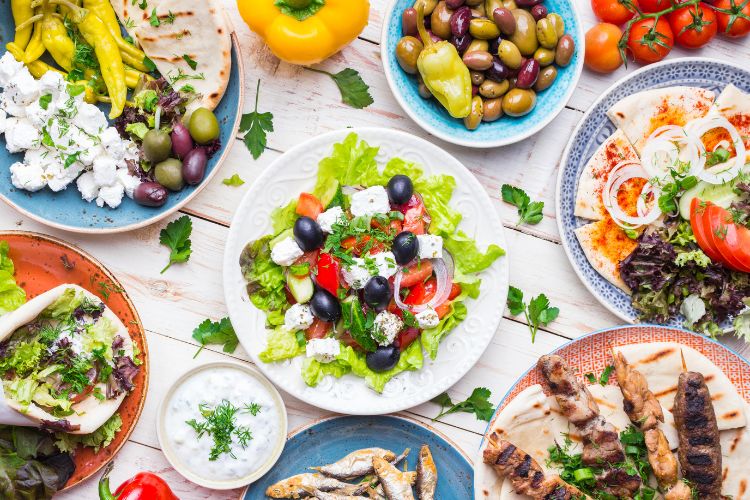
At its core, the Mediterranean diet is a combination of fresh, high-quality ingredients prepared in a manner that enhances both flavor and nutritional value. It promotes a balanced approach to eating, encouraging the consumption of a diverse range of foods in moderation. Here are the main food categories that make up the Mediterranean diet:
Plant-Based Foods: A significant portion of the diet consists of vegetables, fruits, legumes, nuts, and whole grains.
Healthy Fats: The use of olive oil as a primary source of fat, which is rich in monounsaturated fats that are beneficial for heart health.
Lean Proteins: Incorporation of lean proteins such as poultry, fish, and legumes, while reducing the intake of red meat.
Herbs and Spices: A generous use of herbs and spices, which not only add flavor but also have numerous health benefits.
Moderate Dairy Intake: Consumption of dairy products, mainly cheese and yogurt, in moderate quantities.
Specific Foods & Ingredients Involved in the Mediterranean Diet
Olive Oil

Within the broad range of Mediterranean cuisine, olive oil arguably stands at its heart. It’s both a medium for cooking but also a source of numerous health benefits. The Mediterranean region as a whole includes a broad range of olive oils, including extra virgin olive oil, known for its high antioxidant content and ability to promote heart health.
Selecting a premium olive oil is akin to choosing a fine wine, where nuances in flavor, aroma, and texture are deeply influenced by terroir and production methods. Extra virgin olive oil, a product of cold-pressing olives, is the method that retains the highest amount of nutrients and antioxidants. This oil is characterized by an acidity level below 0.8%, superior quality and health benefits, including anti-inflammatory properties due to compounds like oleocanthal.
When sampling extra virgin olive oil options, taste testing regions can be a rewarding experience. While Spain stands as a titan in the industry, contributing about 44% of the world’s supply, other countries are noteworthy contenders. Italy and Greece are classic producers, with regions like Tuscany and Crete producing oils with distinctive flavors and aromatic profiles. Venturing further, you might find surprising gems from Portugal and Croatia.
RELATED: 15 Best Wine Regions in Europe if You Love the Seaside
Fruits and Vegetables
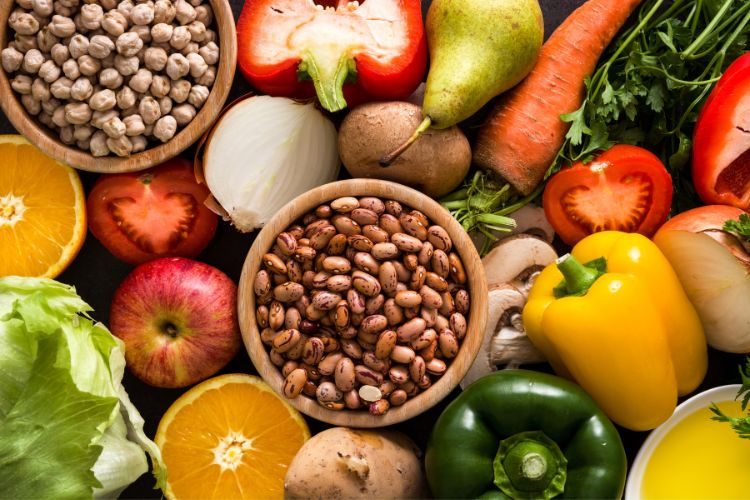
The Mediterranean region is known for its seasonal picks, such as figs in summer and citrus fruits in winter, each offering a unique set of nutritional values. For instance, tomatoes, a staple throughout the region, are rich in lycopene, a powerful antioxidant.
To incorporate more of these nutrient-dense foods into meals, consider starting your day with a vegetable-rich omelet (egg white omelets are great for lowering cholesterol, but including the yolks, in moderation, which contain choline, have more recently shown to be very beneficial to brain health) or enjoy a fresh fruit salad as a snack, a delightful way to infuse special flavors and textures into your daily diet.
Whole Grains
Whole grains serve as the energy providers in the Mediterranean diet, being a rich source of fiber and nutrients. Commonly used grains include farro, bulgur, and barley, each bringing different textures and flavors to dishes.
Farro is an ancient grain, known for its nutty flavor and can be used in a variety of dishes, from salads to soups. When it comes to cooking techniques, consider trying your hand at making a traditional Tabouleh salad with bulgur or a hearty barley soup, recipes that have been passed down through generations in the Mediterranean region (more on these below).
Proteins: Lean Meats and Legumes
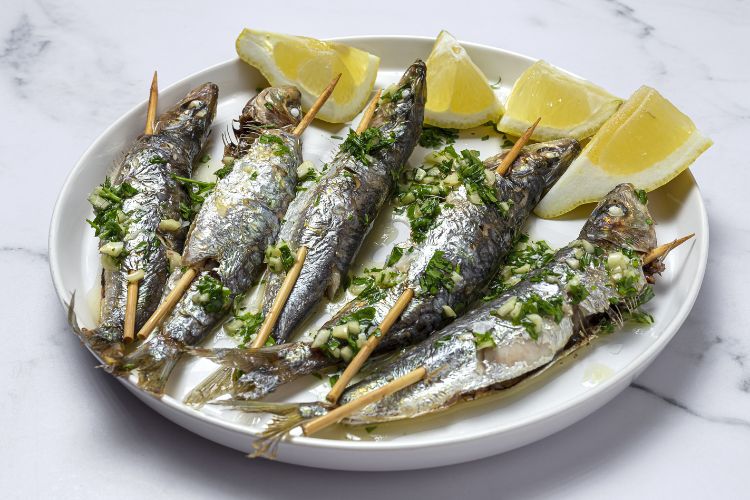
Proteins, particularly lean meats and legumes, play a vital role in the Mediterranean diet. The emphasis is often on fish and poultry, which provide a rich source of omega-3 fatty acids and lean protein. The region is known for its seafood dishes, such as the Greek dish “Psari Plaki,” a baked fish dish with a rich tomato sauce.
The legumes category includes lentils, chickpeas, and beans, and they serve as an excellent source of plant-based protein, often showcased in dishes like the Spanish “Lentejas,” a hearty lentil stew. Interestingly, legumes have been cultivated in the Mediterranean region for thousands of years, serving as a staple in the diet since ancient times.
Dairy: Cheese and Yogurt
Dairy products, particularly cheese and yogurt, add a creamy texture and rich flavor to the Mediterranean diet. The region is home to a variety of cheeses, including Feta from Greece and Pecorino from Italy. Both are classic examples to keep an eye out for on any menu or when cooking. They add distinct a flavor profile that can elevate any dish unique to the Mediterranean.
Yogurt tends to be enjoyed as a snack or used as a base for sauces, and it plays a significant role in the diet, known for its probiotic content that promotes gut health. A fun fact to note is that yogurt has been a part of the human diet for at least 5000 years, with the Mediterranean region being one of the early adopters of this nutritious food.
Foods to Avoid if You’re Considering Trying the Mediterranean Diet
We suggest avoiding highly processed foods such as pre-packaged snacks, sugary cereals, and canned soups, which often include added sugars, unhealthy fats and excess salt. Limit your consumption of red meats like beef and pork, as well as full-fat dairy products such as butter and cream, which are high in saturated fats.
Perhaps most importantly, start restricting carbohydrates found in white bread and pastries. Sugary drinks should also be avoided. Check the labels the next time you go to the grocery store, if you see “Added Sugar,” — steer clear. But also keep in mind that while fruit juices, even those without added sugars, can offer some vitamins and minerals, they are high in natural sugars which can contribute to an increased caloric intake. Consuming them in large quantities can lead to an excess of carbohydrates in the body, which may be stored as fat if not utilized for energy.
Juices also lack the fiber found in whole fruits, which help give you that feeling of fullness and supports digestive health. We recommend consuming fruit juices in moderation, or eliminating them completely as part of a balanced diet. Try prioritizing the consumption of whole fruits to reap the maximum health benefits of the Mediterranean diet.
The Mediterranean Diet: A Lifestyle, Not Just a Collection of Foods
While the above food categories are the main staples in the Mediterranean diet, it’s important not to look at the diet as just a collection of foods to eat or avoid, but as a true cohesive lifestyle that promotes health and happiness, ultimately leading to longevity.
Physical activity is a cornerstone of the Mediterranean lifestyle, characterized by regular, moderate exercises that seamlessly integrate into daily routines. The emphasis is on incorporating movement naturally into one’s day-to-day life, thus promoting cardiovascular health, enhancing metabolic function, and promoting muscular strength and flexibility.
The inhabitants of the Mediterranean region traditionally engage in activities such as walking frequently on cobbled streets, cycling, and agricultural tasks, which not only facilitate physical well-being but also harmonize with the principles of sustainable living.

Social engagement, particularly during meal times, is another pivotal aspect of the Mediterranean lifestyle. This practice underscores the significance of community and familial bonds in enhancing mental health and overall well-being. Scientific evidence suggests that social interactions during meals can potentially lead to better mental health, reduced feelings of isolation, and improved quality of life. In the Mediterranean culture, meals often serve as a platform for fostering connections, facilitating meaningful conversations, and nurturing relationships, thereby contributing to a supportive and enriching social environment.
Different Dishes from Countries & Regions in the Mediterranean
Greece
In Greece, the diet is punctuated with dishes like Moussaka, a layered eggplant and meat casserole, and the famed Greek Salad, a fresh concoction of tomatoes, cucumbers, olives, and feta cheese, generously drizzled with olive oil.
The Greeks also have a penchant for legumes, often showcased in dishes like Fasolada, a white bean soup that is considered the national food of Greece.
Italy
Italy is unparalleled when it comes to its gastronomic offerings throughout diverse regions with varied microclimates. In the coastal areas, you’ll find dishes like Risotto alla Pescatora, a seafood risotto that features fresh produce from the sea.
RELATED: The Best Wine Tours & Wine Tasting Experiences in Tuscany
The central regions are known for their olive oils and wines, with dishes like Pasta Carbonara, which originates from Rome, being a staple.
In the southern regions, including Sicily, you can find dishes like Caponata, a sweet and sour eggplant dish that stands out for its flavor and history.
Spain
In Spain, the Mediterranean diet is also rich in a variety of foods, including the world-renowned Paella, a rice dish that combines seafood, meats, and vibrant spices
Another staple is Gazpacho, a cold soup made from tomatoes, peppers, cucumbers, and onions, a refreshing and nutritious option especially during the summer months.
North Africa
Moving to North Africa, countries like Morocco and Tunisia introduce more exotic flavors and textures to the Mediterranean diet. Moroccan cuisine offers dishes like Tagine, a slow-cooked stew that combines meats with a variety of fruits, spices, and nuts. Tunisian cuisine, on the other hand, is known for dishes like Couscous, often served with a medley of vegetables and meats, seasoned with a blend of aromatic spices.
Western Asia
In Western Asia, countries like Turkey and Lebanon contribute significantly to the Mediterranean culinary scene. Turkish cuisine includes dishes like Meze, a selection of small dishes that showcase the variety of foods available in the region, including items like stuffed vine leaves and Baba Ganoush, an eggplant-based dish.
Lebanese cuisine is known for its dishes like Tabouleh, a fresh parsley and bulgur salad, and Kibbeh, a dish made from minced meat and bulgur wheat, showcasing the region’s emphasis on fresh produce and whole grains.
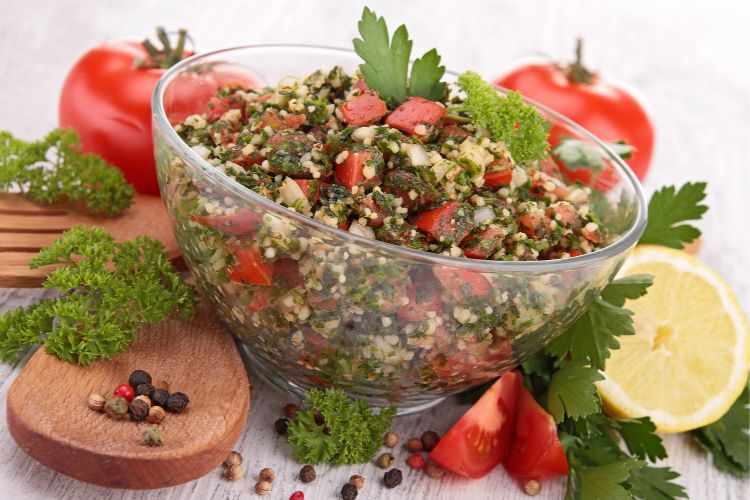
Mediterranean Dishes and Recipes to Try at Home and Out and About
Embarking on a culinary journey through the Mediterranean diet provides an opportunity to explore an indescribable range of dishes that not only tantalize taste buds but also provide significant nutrional benefits.
From breakfast options to hearty lunches and dinners, the Mediterranean diet presents a delightful gastronomic experience. Let’s go a bit deeper into a selection of recipes our team put together that embody the essence of this diet, featuring both classic and unique dishes that can be enjoyed throughout the day.
Breakfast Options
The Mediterranean breakfast is kind of a flashy affair. One classic option is the Greek Yogurt Parfait, layered with fresh fruits like berries and a sprinkle of nuts and honey. For a unique twist, you might try Shakshuka, a North African dish that has found its place in Mediterranean cuisine. It consists of poached eggs in a spicy tomato sauce, if you’d prefer a heartier and spicier start to your day.
Greek Yogurt Parfait
A light, refreshing and nutritious start to your day, this parfait combines the creaminess of Greek yogurt with the freshness of berries. It’s low in fat, can include substantial fiber, and loaded with probiotics and antioxidants.
- Layer Greek yogurt with fresh berries, a sprinkle of granola, and a drizzle of honey.
- Top with a sprinkle of chia seeds and a few mint leaves for a refreshing touch.
Shakshuka
This North African dish has seamlessly blended into the Mediterranean breakfast repertoire.
- In a skillet, sauté onions and garlic until translucent.
- Add diced tomatoes, bell peppers, and spices like cumin and paprika. Let it simmer until the sauce thickens.
- Make wells in the sauce and crack eggs into each well. Cover and cook until the eggs are done to your liking.
- Serve hot with a sprinkle of fresh parsley and a side of crusty bread.
Lunch and Dinner
The fun thing about Mediterranean dining style is that things just continue to get more interesting as the day goes on. Lunch and dinner spreads typically feature an abundance of salads and main courses that include a balanced meal experience.
As we mentioned earlier, a classic option is the Greek Salad, a blend of tomatoes, cucumbers, olives, and feta cheese. For a unique main course, you might consider a Moroccan Tagine, a slow-cooked stew that combines meats with a variety of fruits, spices, and nuts.
Greek Salad
This simple but visually appealing, tasty and heart-healthy dish is easy to prepare.
- Combine chopped tomatoes, cucumbers, red onions, and Kalamata olives in a bowl.
- Crumble feta cheese on top and drizzle with olive oil and a splash of red wine vinegar.
- Toss well and garnish with fresh oregano.
Moroccan Tagine
Experience the classic flavors of Morocco. Combining meats with fruits, spices, and nuts.
- In a tagine or a heavy-bottomed pot, sauté onions and garlic until golden.
- Add chunks of lamb or chicken, followed by spices like cinnamon, cumin, and coriander.
- Add dried fruits like apricots or prunes and a splash of chicken or vegetable broth.
- Cover and simmer until the meat is tender and the flavors meld together.
- Serve with a side of couscous or bread.
Snacks and Desserts
Aside from traditional main courses, the Mediterranean diet also includes a snacks and desserts that satisfy the palate without straying from the diet’s principles.
For a healthy snack, consider a plate of fresh fruits with a side of nuts.
When it comes to desserts, a classic option is Baklava, a sweet pastry made with layers of filo pastry, nuts, and honey.
For a unique dessert, you might try a Fig and Olive Oil Cake, a moist cake that combines the sweetness of figs with the richness of olive oil.
Fresh Fruit and Nut Platter Recipe
- Arrange slices of seasonal fruits like apples, pears, and grapes on a platter.
- Add a selection of nuts like almonds and walnuts for a crunchy texture.
- Serve with a side of honey or yogurt for dipping.
Simple Baklava Recipe
- Layer sheets of filo pastry in a baking tray, brushing each layer with melted butter.
- Spread a mixture of chopped nuts and cinnamon between the layers.
- Bake until golden and crisp, then pour a syrup made of honey and water over the top.
- Allow it to soak in before slicing and serving.
Fig and Olive Oil Cake Recipe
- In a bowl, combine flour, baking powder, and salt.
- In another bowl, whisk together eggs, sugar, and olive oil until smooth.
- Add the dry ingredients to the wet ingredients, followed by chopped fresh figs.
- Pour the batter into a prepared cake tin and bake until golden and a toothpick inserted comes out clean.
- Serve warm, perhaps with a dollop of Greek yogurt on the side.
Wine and the Mediterranean Diet
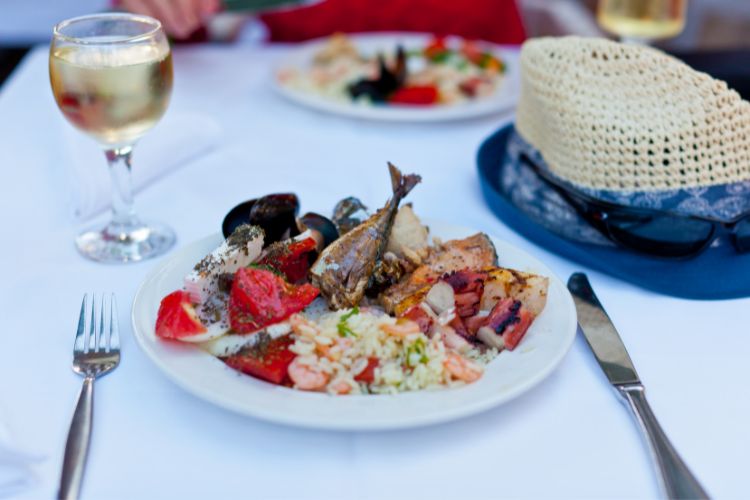
The Role of Wine in the Mediterranean Diet
Wine holds a special place in the Mediterranean diet, often enjoyed with meals, especially during social gatherings and family dinners. It’s not just a beverage but an integral part of the whole dining experience, enhancing the flavors of the food and helping to further a sense of community and enjoyment.
RELATED: Learn More About How Wine & Food Pairings Work
Historical and Cultural Significance
Historically, wine has been a staple in the Mediterranean region for thousands of years. It has been used in religious ceremonies, celebrations, and crucially as a daily accompaniment to meals. The art of winemaking was and still is a cherished tradition in the region, passed down through generations.
Health Benefits of Wine When Consumed in Moderation
When enjoyed in moderation, wine offers several health benefits. It’s known to contain antioxidants like resveratrol, which has been linked to heart health. Additionally, moderate consumption of wine can potentially aid in reducing the risk of certain chronic diseases.
Wine Pairings
A Guide to Pairing Wine with Mediterranean Dishes
Pairing wine with Mediterranean dishes can elevate your dining experience. Here’s a simple guide to help you make the best choices:
- White Wines: Typically pair well with dishes like grilled fish, salads, and chicken dishes. A crisp white wine can complement the fresh flavors of Mediterranean cuisine.
- Red Wines: Are great companions to hearty dishes like stews, grilled meats, and pasta dishes. A robust red wine can balance the rich flavors of these meals.
- Rosé Wines: Can be paired with a wide variety of dishes, including seafood, salads, and grilled vegetables, offering a versatile option for wine pairing.
Spotlight on Regional Wines: Highlighting a Few Regions and Their Signature Wines
The Mediterranean region is home to several renowned wine-producing areas, each offering unique and distinctive wines. Here are a few highlights:
- Tuscany, Italy: Known for Chianti, a red wine that pairs excellently with pasta and meat dishes.
- Provence, France: Famous for its rosé wines, which are perfect for enjoying with seafood and light salads.
- Rioja, Spain: Home to a range of red wines that complement a variety of Spanish dishes, including paella and tapas.
RELATED: The Are the Best Wineries & Vineyard Resorts in Rioja to Visit
Tips for Enjoying Wine the Mediterranean Way
To truly enjoy wine the Mediterranean way, consider the following tips:
Savor Slowly: Mediterranean culture encourages savoring wine slowly, enjoying each sip and the flavors it brings to the meal.
Socialize: Wine is usually enjoyed in a social setting, promoting conversation and bonding with family and friends.
Pair Wisely: Learn the art of pairing wines with different dishes to enhance each experience.
Moderation: The key to enjoying wine (and food for that matter) and their benefits is moderation, ensuring they complement each other rather than overshadow a meal.
You are reading “What is the Mediterranean Diet? Understanding Its Benefits and How it Works” Back To Top
Mediterranean diet food list, Mediterranean health benefits, Mediterranean diet and wine, what foods to avoid with the Mediterranean diet: articles related to wine education
If you enjoyed this guide, make sure you register to become a Winetraveler for free! You’ll get access to all of our content and interact with other Winetravelers and for travel inspiration around the world. Be sure to follow along with us on Twitter and Instagram as we continue to feature more exciting destinations.
